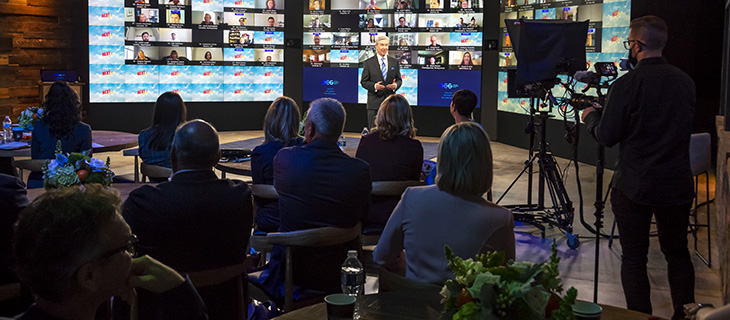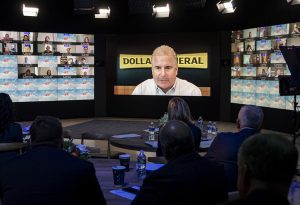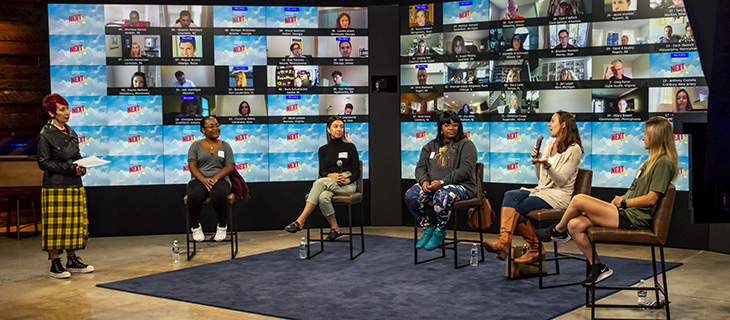Virtual event's speakers focused on 'What's Next?'

Ed Morgan, president and partner of Emerson Group, co-hosted the virtual event.
PHILADELPHIA — While the COVID-19 pandemic is by no means a thing of the past, its profound impact over the last 18 months on so many different aspects of life has naturally raised the question of what lies ahead, what is next — for individuals, for society, for industry.
For the retail industry as a whole and the supplier community that supports it, that is a pressing question, both for the near term and the long-term. To explore some of the possible answers during its annual Industry Day, the Emerson Group assembled, both virtually and in person, a distinguished lineup of experts and executives from a number of the leading players in the food, drug and mass channels and the consumer packaged goods industry.
As in past years, the Industry Day program consisted of presentations, interviews and panel discussions on a variety of topics all keyed to the event’s theme, “What’s Next?” It featured an exceptional range of speakers both within and outside of the industry, including, for example, Jennifer Doudna, a Nobel Prize co-winner and biochemist at the University of California, Berkeley, and Jocko Willink, retired U.S. Navy Seal, author and podcaster. In addition to Willink’s riveting presentation, other discussions of leadership featured executives from such major suppliers as Unilever, Johnson & Johnson, GlaxoSmithKline PLC and Procter & Gamble Co.
Co-host Ed Morgan, president and partner of Emerson Group, described the three goals of the event: first, to expand and reframe participants’ thinking; second, to envision the future; and third, to build for success in the COVID and post-COVID world.

Ed Morgan with on-screen Scott Galloway.
Leading off the day was Scott Galloway, professor of marketing at the Stern School of Business at New York University, who predicted that the COVID-19 pandemic will be remembered more as an accelerant than a change agent, pointing to the spectacular growth of online grocery, which compressed six years of predicted growth into one, and e-commerce, which leapt forward by 10 years.
Galloway also suggested that the U.S. economy is on the cusp of another major paradigm shift (following globalization and digitization) to dispersion, which he defined as the fundamental reconfiguration of the supply chain in order to distribute products or services over a wide area. He went on to assert that the industry that will change most through dispersion is health care.
“We’ve pushed out a massive amount of health care, through smartphones and smartspeakers to the Web,” he said. “And people have been getting treated at home. Less than 1% of doctors’ visits were virtual pre-pandemic. It’s now almost a third. We’ve made more progress toward virtual health in the last 18 months than we made in the previous 18 years.”
However, Galloway warned that Amazon, the e-commerce giant, is poised to become the fastest-growing health care company, driven by a need to continue growing revenue. “They are clearly putting all the pieces in place to take health care from a defensive, on-our-heels industry to an offensive, on-our-toes industry,” he remarked. “Watch out health care: Here comes Amazon.”
Despite the shadow cast by Amazon, several speakers felt that community pharmacy has ample reason to be upbeat about the future, having emerged from the COVID crisis with renewed faith in its value and its demonstrated ability to play a greater role in health care and achieve improved health outcomes and reduce health care costs.
“I truly do believe we are the front doors of health care; we have been for quite some time,” said Colleen Lindholz, president of Kroger Health and current chair of NACDS. “And as we expand our scope of practice we can do more. Immunizations are an example. We’re going to be more integral, and a lot of that is because of our access points and the trust — we are often the No. 1 or No. 2 most trusted health care professionals — so I’m excited about what the future holds.”
Steve Anderson, president and chief executive officer of NACDS, was similarly upbeat. “I think the future is going to be great,” he said. “It’s all going to be driven by technology, obviously. Telehealth is huge and moving forward, and that plays right into pharmacy’s strengths. The future is going to be really exciting.”
Neela Montgomery, president of CVS Pharmacy and executive vice president of CVS Health, pointed out that the drug chain’s role in administering first tests and then vaccines in the pandemic has facilitated its transition to a consumer-focused digital health care company and, in effect, a health care destination.
“We’ve always been synonymous with health, but clearly our role in the pandemic, in testing and vaccine — we’ve administered over 30 million vaccinations — that kind of pivot to becoming a community health destination has been quite remarkable,” she said. “Just in the last eight months we’ve invited more than 8 million new customers — those who haven’t filled scripts at CVS — to come and get a vaccination in our stores. I think this has really been a pivotal moment for people to rethink what CVS means to them.”
The pandemic, in fact, has created opportunity for all of community pharmacy, according to John Standley, president of Walgreens and executive vice president of Walgreens Boots Alliance. The pandemic, he said, has reminded many of retail pharmacy’s constituents of the importance of community pharmacy, whether customers and patients, or government, or PBMs. The role pharmacy has played over the past year has highlighted its relevance as never before.
Standley pointed out that Walgreens’ abundant resources have enabled it to invest in technology and infrastructure that are giving the company more insights and capabilities related to customers and patients. “I think the challenge is on us to bring all that to bear in a way that really differentiates us,” he said. “We have everything we need to be successful, so if we’re not, it’s on us. So we really need to just get after it and make it happen.”
All three of the largest drug chains are, in fact, in the process of developing new business models for retail pharmacy, models that are less vulnerable to the reimbursement pressures that now threaten the industry’s viability. Rite Aid Corp. launched its drive, dubbed RxEvolution, to create a new drug store concept, one that is focused on an expanded, customer-facing role for the pharmacist, before the pandemic struck.
RxEvolution, explained president and CEO Heyward Donigan, has three core pillars, starting with elevating the role of the pharmacists by having them practice at the top of their license and engaging with the customer. In addition, the company is recreating the customer’s in-store and digital experience by moving into the modern era of omnichannel customer interactions. The third pillar involves establishing Elixir, the company’s own PBM, as a clearly differentiated market leader.
Dr. Cheryl Pegus, executive vice president of health and wellness at Walmart U.S., observed that the pandemic revealed that people are prepared to take control of their health, a fact that intersects perfectly with the expanded, patient-facing role of the pharmacist.
“What they need is information and multiple access points for their health and wellness,” she said. “We call that omnichannel access for health and wellness. We’re seeing people get a lot of services in-home. One of the ways we look at that is through telehealth, which is not having to wait three months to see a physician. It really allows a person who thinks they may have an acute problem not to go to the emergency room but to get that care right now through a video visit.”
Pegus further pointed out that more than 4,000 of Walmart’s store locations are in medically underserved areas, and the retailer’s omnichannel health and wellness capabilities are bringing health care to the underserved when they need it and where they want it.
While health care issues dominated much of the discussion throughout the day, other topics, such as e-commerce, retailer-supplier partnerships and leadership, also were explored. In addition, an interview with Todd Vasos, CEO of Dollar General Corp., shed light on the factors that have driven the extraordinary success of perhaps the best-performing company in mass retail.

Dollar General CEO Todd Vasos
Vasos attributed that performance to a number of factors, including a heightened emphasis on strategic planning that looks as far as 10 years out. Additionally, the management ranks were strengthened by bringing in outstanding talent — Vasos himself is an example, having joined Dollar General as chief merchandising officer 13 years ago — from other trade classes. Those changes enabled Dollar General to recreate itself as a general store offering unbeatable prices to underserved rural communities.
One of the most stunning aspects of Dollar General’s success has been its rapid and continued expansion, for which Vasos credited the company’s outstanding real estate team and processes. When he arrived at Dollar General, it had approximately 8,000 stores, was under private equity ownership, and was not growing. Now the store count is over 18,000 and the chain is opening approximately 1,000 new stores a year, in addition to constant remodels on a large scale.
“We see 17,000 more opportunities in the continental U.S.,” he remarked. “We won’t get all those sites, but we feel very comfortable about [projecting] 6% square footage growth, and that will land us in that 1,000 to 1,100 stores a year on average.”
Dollar General’s continued growth is all the more remarkable when the retail industry as a whole has seen a dramatic drop in store counts over the past several years.

WSL Strategic Retail CEO and chief shopper Wendy Liebmann asked a panel of shoppers about what’s next for them.
Wendy Liebmann, CEO and chief shopper of WSL Marketing Inc., moderated The Live Shopper Focus Group during a morning session. In keeping with her company’s belief that retailers and suppliers who want to know what’s next should “follow the shopper,” Liebmann asked panelists about how their shopping behaviors changed during the pandemic, and which changes are likely to stick when life returns to normal.




You must be logged in to post a comment Login